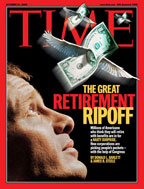 Time magazine’s recent cover story, “The Great Retirement Ripoff,” pictured a distraught man watching winged $100 bills fly into an empty, black void. If that striking visual isn’t enough to make you shudder, the piece contained a description of the Polaroid ESOP’s collapse. Its conclusion: The ESOP was a “ripoff” that paid employees $47 dollars for their ownership stakes, while post-bankruptcy management sold their non-ESOP shares for millions.
Time magazine’s recent cover story, “The Great Retirement Ripoff,” pictured a distraught man watching winged $100 bills fly into an empty, black void. If that striking visual isn’t enough to make you shudder, the piece contained a description of the Polaroid ESOP’s collapse. Its conclusion: The ESOP was a “ripoff” that paid employees $47 dollars for their ownership stakes, while post-bankruptcy management sold their non-ESOP shares for millions.
Whether you agree or disagree with the article, one fact is certain: If you don’t communicate about your plan, someone, somewhere will. Your employees — and their families and friends — are reading articles detailing the death of retirement plans and listening to television shows explaining the “dangers” of stock ownership. In this negative environment, you can sit still and hope for the best. Or you can proactively use the steps below to build understanding of, and enthusiasm for, the valuable benefits of employee ownership.
Remove the Black Void of Ignorance
Most people are unfamiliar with employee ownership — whether it’s in an ESOP, company stock in a 401(k) plan or stock options. Ignorance is not bliss; all too often it creates susceptibility to the latest rumor, especially from a “credible” source. Fill that void with basic facts: why the plan was created, where the company is headed and what it means to own company stock.
Go beyond handing out the required information, such as the summary plan description. Avoid legalistic, convoluted explanations and present the information in layman’s terms. Employees, even highly educated professionals, often lack the basic ownership skills and knowledge.
Attack the ripoff notion head-on
Many employees are confused and suspicious because ownership plans are frequently provided at no cost. “Free benefit” fails the “sniff” test. Grumblings of “no one gets something for nothing” arise, and the rumor mill’s negative spin falls into place.
Attack these misconceptions by explaining your plan’s benefits. If selling shareholders are receiving government-created tax benefits in an ESOP, tell employees. Explain that they will enjoy tax benefits from the ESOP as well. While doing that, paint a vision of success by illustrating why the company has employee ownership and what your hopes and dreams are for the company’s future.
Focus on the winged $100 dollar bills
A key to employee education is discussing topics people are interested in when they’re interested in listening. Negative media stories can actually help: they provide a reason to talk about your plan.
A better approach, though, is investing time to develop an ownership-communications strategy with specific goals and clear roles for who does what, when and how. Proactive planning guides your efforts, providing you with a measuring stick to track your progress. If you’ve been employee owned and don’t have a communications plan, now is the time to start.
If you’re just rolling out a new plan, it’s important to explain what’s in it for “me.” Flying hundred dollar bills and real-world examples will get people’s attention. If you’ve missed that initial opportunity, there’s no reason you can’t revisit these issues and the importance of stock valuation when participant statements are distributed.
Don’t stop there. People absorb information – especially complex data – over time. The initial announcement or statement presentation is the first step of an ongoing communication and education process which can include educational events, hands-on training, written materials and integrating ownership concepts into company events, intranet sites and employee-ownership month activities.
Take the time to tell stories of success. Employee milestones, like 100% vesting for example, provide you with an opportunity to recognize achievements. Celebrate retirements: feature retirees in the newsletter and let them brag about their post-employment plans and how they’re going to spend all those winged $100 bills.
Make the negatives positively understood
Employee ownership is an excellent opportunity for everyone to benefit from their day-to-day efforts serving customers, producing quality products and improving company profits. It, like anything else, also has downsides. The only way to fight negative perceptions is to expose them to the light of day. You can, for instance, compare and contrast your plan with a 401(k) or another retirement benefit. Each plan has strengths and weaknesses; employee ownership’s benefits become clearer in direct comparisons.
More than a decade ago, Rutgers Professor Joseph Blasi published the provocatively titled book: “Employee Ownership: Revolution or Ripoff?” Since that time, millions of employees have benefited from their company’s employee ownership plans, yet the question still remains. Your internal communications determine whether your employees see your plan as a beneficial retirement revolution or a ripoff.
Remember, if you don’t tell your story, someone else will.
This is a reprint of an article by Jim Bado first appeared in an NCEO member newsletter in 2006. Contact Jim at jbado@workplacedevelopment.com for more on WDI helps ESOPs to tell their story.


